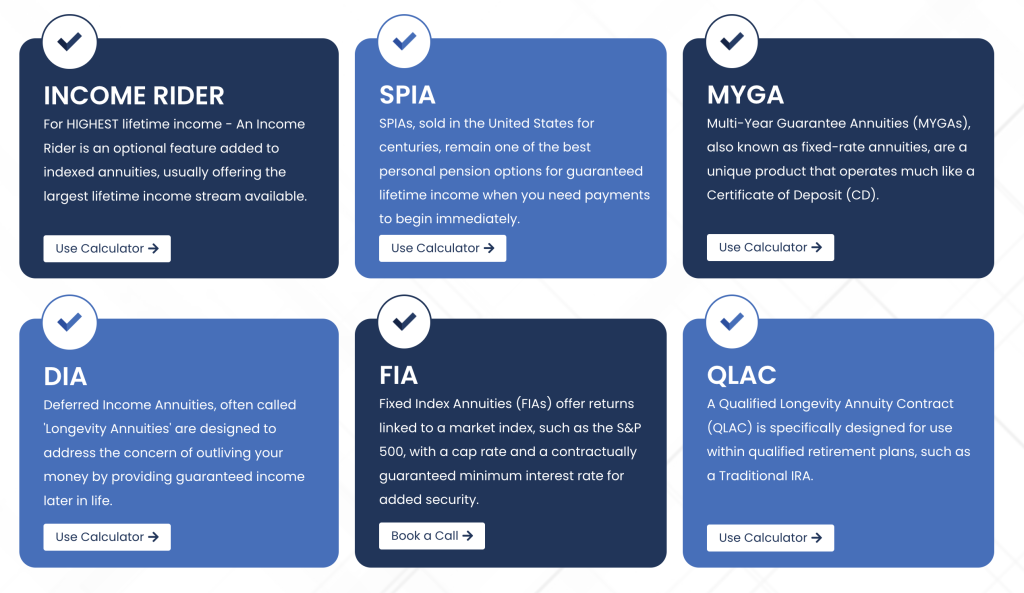
Are you looking for a reliable retirement income source that can provide peace of mind throughout your golden years? Do you want to see how much an annuity could pay you without first needing to speak to anyone?
An online annuity calculator can provide the information you need so you can compare the best annuities for your unique situation.

Summary
- Use our annuity calculator here to compare every annuity in one place at your fingertips. You’ll get instant, personalized rates and quotes from all the top carriers. It’s quick & easy. No obligations.
- An annuity income calculator is a useful tool for exploring retirement options and estimating potential payouts.
- Consider different types of annuities, including fixed, & indexed ones to determine which best meets your financial needs & goals.
- Our annuity calculator can help you compare the various features with each option.
Need help choosing the best annuity for your unique situation? If so, it’s best to speak with an annuity specialist. Watch this short video to see how I can help you do this (at no cost to you!).
Understanding Annuity Income Calculators

An annuity income calculator, an invaluable tool, enables estimation of your retirement income considering age, investment amount, and desired income start date.
This includes immediate and deferred annuity options. Such calculators offer insights into potential income from various annuity options, enabling better decision making for your retirement income strategy.
How Annuity Income Calculators Work
An annuity income calculator utilizes user-provided information to generate estimates of potential retirement income from various annuity options.
By answering the question of how much monthly income one can expect, the calculator, considering the timing of payments and potential fund accumulation, offers an approximate estimated monthly income for retirement from a range of annuity options offered by various insurance companies.
For example, when considering immediate annuities, the calculator evaluates the present value of a series of annuity payouts while taking into account deferred annuities by assessing the growth of funds over a predetermined period of time prior to the commencement of annuity payouts.
Utilizing an annuity income calculator enables informed decision-making regarding your retirement income strategy and the selection of the most suitable annuity option according to your individual needs and financial goals.
Benefits of Using an Annuity Income Calculator
One of the key benefits of using an annuity income calculator is the ability to explore different annuity options and evaluate their payout rates, allowing you to weigh the pros and cons of each option and make a well-informed decision.
For instance, the calculator available on johnstevenson.com allows you to select what is most important to you, such as accumulation for retirement, lifetime income, or leaving a legacy with death benefits.

Additionally, an annuity calculator can help you project the long-term benefits of your chosen annuity by calculating future cash flow and payments based on the initial premium, interest rates, and duration of the annuity.
The insights from an annuity calculator enable confident and sound investment decisions that align with your retirement goals and financial needs.
Types of Annuities to Consider

Annuities come in various forms, each offering distinct features and advantages tailored to meet the diverse needs of retirees. This section discusses three main types of annuities: fixed annuities, variable annuities, and indexed annuities.
Understanding the characteristics of each type allows for more informed decisions when selecting the annuity option that best suits your retirement goals and risk tolerance.
Fixed Annuities
Fixed annuities are a type of financial product that guarantees a payment after a specific date, with the return rate largely determined by market interest rates at the time the annuity contract is established.
The payout amounts of fixed annuities are based on the contract value and the length of the payout period, while the rates on fixed annuities are derived from the yield generated from the life insurance company’s investment portfolio.
Fixed annuities are generally considered a lower-risk option, offering predictable investment returns and tax-deferred growth opportunities, as well as secure and dependable income.
However, they may not offer the same growth potential as riskier investments, and early withdrawals may incur surrender charges or tax penalties.
Investing in fixed annuities necessitates evaluation of factors such as income options, risks and benefits, tax-deferred savings, financial and tax status, and simplicity.
Variable Annuities
Variable annuities, on the other hand, are investment products that provide returns that depend on market performance, with the potential for higher returns but also increased risk.
The return on a variable annuity is determined by the performance of the underlying investments, such as bonds and mutual funds, rather than a fixed rate of return as with a fixed annuity.
While variable annuities may offer higher returns than fixed annuities, they also involve investment risks similar to those found in mutual funds, such as:
- Poor investment performance
- Equity and interest rate risks
- Market volatility
- Potential losses
- High fees
- Complexity
Prior to investing in variable annuities, careful assessment of these risks against potential benefits and returns is necessary.
Indexed Annuities
Fixed indexed annuities offer a unique combination of fixed and variable annuity features, providing a guaranteed minimum return and the potential for additional returns based on market performance.
The performance of a particular market index, such as the S&P 500, affects the returns on fixed indexed annuities, with higher returns when the market index performs well and lower returns when the market index performs poorly.
The advantages of indexed annuities include security against loss, a guaranteed minimum return, and the possibility of higher returns than those of traditional fixed contracts.
However, they also involve more risk than fixed annuities, may include early withdrawal penalties or surrender charges, and could lead to a loss of buying power.
Like any investment decision, careful evaluation of the pros and cons of indexed annuities is necessary before commitment.
Navigating Annuity Fees and Charges

In addition to understanding the different types of annuities, it is crucial to consider the fees and charges associated with annuities when evaluating your investment options.
This section focuses on surrender charges, commissions, and administrative fees, which can notably impact the overall value of your annuity investment.
Understanding Surrender Charges
Surrender charges are fees imposed when an annuity is withdrawn prior to a specified duration, with the magnitude of the fee and the period of time that must elapse before it can be withdrawn without incurring a fee varying according to the annuity.
The average rate of surrender charges for annuities typically ranges from 5% to 25% of the amount withdrawn, with the surrender charge period usually lasting seven to ten years.
Awareness of surrender charges associated with your annuity contract is vital as these fees can significantly impact the overall value of your investment.
Additionally, some annuities offer a free-look provision, which allows new holders to terminate their policies without incurring surrender charges within a period of 10 to 30 days from the date of signing the contract.
Evaluating Commissions and Administrative Fees
Commissions and administrative fees are additional costs that can affect the overall value of your annuity investment. Commissions refer to the fees paid to the insurance company or broker for selling the annuity, which may range from 0% to 8%, depending on the annuity.
Administrative fees, on the other hand, cover the costs of servicing the annuity, such as transferring funds, tracking purchase payments, and issuing statements.
Considering annuity options necessitates a review of each insurance company’s terms and conditions to understand the applicable commissions and administrative fees for their annuities.
By taking these fees into account, you can make a more informed decision when choosing the annuity option that best meets your financial needs and retirement goals.
How to Use our Annuity Calculator

Now that you have a better understanding of annuities and the associated fees and charges, you may be wondering how to use an annuity calculator to estimate your potential retirement income.
This section will guide you through the process of using our annuity calculator available on johnstevenson.com to explore various annuity options, compare payout rates, and project long-term benefits.
Accessing the Calculator
To access the annuity calculator on johnstevenson.com, simply follow these steps:
- Click here to access to annuity calculator
- Select what is most important to you
- Input the necessary information to calculate your retirement income with different annuity providers
- If you need help or have questions you can schedule a call with me by clicking here
Most of my clients choose ‘lifetime income’ when looking for an annuity. If you do the same, it enables the calculator to generate an estimate of annuity payments based on the provided information, including immediate annuity and deferred annuity options.
This allows you to explore various annuity options and compare the potential guaranteed lifetime income they could provide during your retirement years.
Inputting Your Information
To generate accurate annuity quotes, you will need to input your details into the calculator. This includes:
- Age
- Investment amount
- Gender
- Marital status
- Desired start date for income payments
Providing accurate information is crucial for ensuring the calculator generates reliable estimates of your potential retirement income.
Keep in mind that gender information significantly influences the calculation of annuity income due to gender-based differences in life expectancy and retirement income.
Inputting accurate information guarantees the annuity calculator provides the most precise and relevant results for your individual circumstances.
Comparing Annuity Options
Once you have input your information and generated annuity quotes, you can use the calculator’s report to compare different annuity options and assess their potential long-term benefits.
This can be particularly helpful in determining which type of annuity is best suited to your retirement goals and risk tolerance.
If you require a more detailed explanation of how annuities work, personalized illustrations, or have any questions, you can schedule a call.
This personalized guidance can further assist you in making informed decisions about your retirement income strategy and selecting the annuity option that best meets your financial needs and retirement goals.
Conclusion
Annuities can be a valuable source of retirement income, providing you with peace of mind and financial security throughout your golden years.
By understanding the various types of annuities available, navigating the fees and charges associated with annuities, and using an annuity calculator, you can make well-informed decisions about your retirement income strategy.

By consulting with an annuity expert, you can make educated decisions regarding your annuity investments, ensuring a safe and secure retirement income strategy that meets your unique financial goals and needs.

